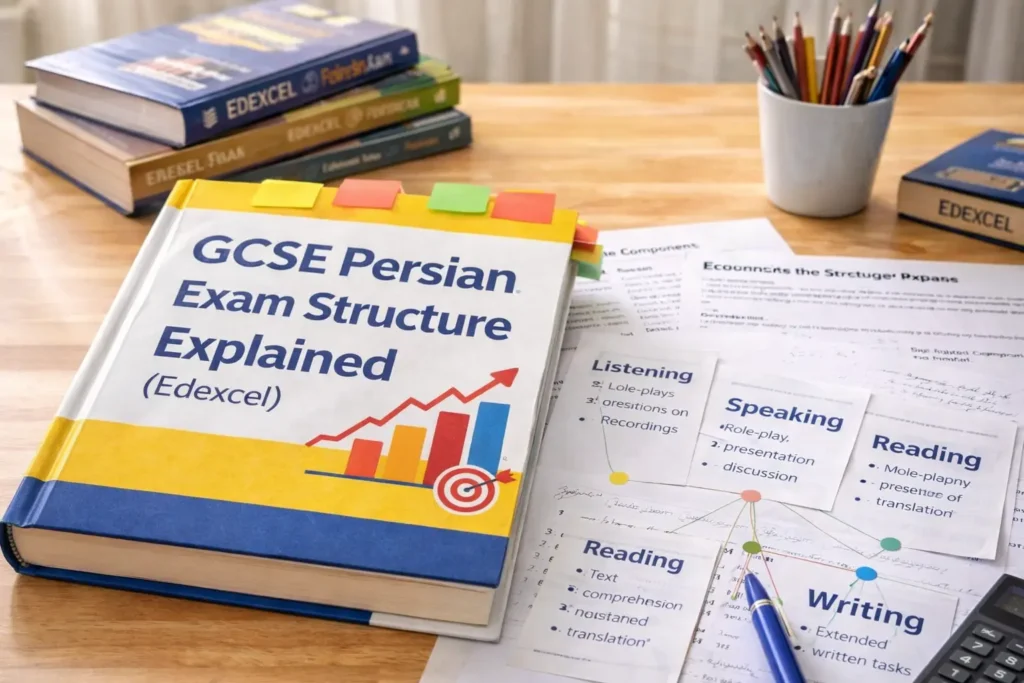Languages are fascinating windows into different cultures, histories, and perspectives. Among the most prominent languages in the Middle East, Arabic and Farsi often get compared or even confused due to geographical proximity and some shared aspects.
But in reality, they’re linguistically distinct with fascinating differences. If you’ve ever wondered about “what is the difference between Arabic and Farsi”, this guide will walk you through key points, from grammar and vocabulary to cultural influences. Plus, we’ll show you how you can learn Farsi with the help of Danaa School’s expert instructors.
Language Family and Linguistic Roots
The first major difference between Arabic and Farsi lies in their linguistic roots. Arabic is part of the Semitic languagefamily, which also includes Hebrew and Amharic. It belongs to the larger Afro-Asiatic language group and is primarily spoken across the Middle East and North Africa.
Farsi, on the other hand, is part of the Indo-European language family, which includes languages like English, German, and Hindi. Farsi, also known as Persian, is the official language of Iran and is also spoken in Afghanistan (as Dari) and Tajikistan (as Tajik).
While these languages co-exist in the same region, their linguistic foundations are worlds apart, which sets the stage for their many other differences.
Grammar Difference Between Arabic and Farsi
When it comes to grammar, the two languages take very different paths. Arabic grammar is heavily influenced by its root system. Most words are derived from three-consonant roots, which dictate how the word is structured, conjugated, and modified. For example, the root “k-t-b” forms words related to writing, such as “kitab” (book) and “kataba” (he wrote). Verb conjugation, noun cases, and gender agreement are also much more complex in Arabic than in Farsi.
In contrast, Farsi grammar is more straightforward. While Farsi does have verb conjugation, it doesn’t follow the trilateral root system that Arabic does. Furthermore, Farsi does not use noun cases, and its verb conjugation system is simpler. One key aspect learners love about Farsi is the lack of gender distinction, making it somewhat easier to pick up for many.
Writing Systems: Arabic Script vs. Farsi Letters
Though both languages use variations of the Arabic script, there are key differences in how they’re written. Arabic has 28 letters, while Farsi (Persian) adds four extra letters, making a total of 32 letters. These additional letters (پ, چ, ژ, and گ) represent sounds not found in Arabic, which accommodates the phonetics of the Farsi language.
Additionally, Farsi script tends to flow differently due to variations in handwriting styles and the presence of these extra characters. This means that while someone familiar with the Arabic script may be able to read Farsi letters, understanding the language itself requires additional learning.
Phonetics and Pronunciation
Phonetically, Arabic and Farsi sound quite distinct. Arabic has several unique sounds that don’t exist in Farsi, including the famous “ح” (h-like sound) and “ع” (a guttural sound that’s challenging for non-native speakers). Arabic also tends to use harsher, more guttural consonants.
Farsi, in contrast, sounds softer. The pronunciation of words in Farsi often resembles European languages due to its Indo-European roots. For example, Farsi’s phonetic system has fewer guttural sounds and places more emphasis on soft vowels, making it easier for some learners to pronounce compared to Arabic.
Cultural Influences on Arabic and Farsi
Both Arabic and Farsi have deep cultural significance in the Middle East, but the cultures they represent are distinct. Arabic is not only the language of over 420 million people but also the language of the Quran, making it central to Islamic faith and practice worldwide. Because of this, Arabic culture is often tied to religious, historical, and philosophical discussions.
Persian culture, tied to the Farsi language, is deeply rooted in literature, art, and history, with contributions to the world of poetry, philosophy, and science. Famous poets like Rumi, Hafez, and Ferdowsi wrote in Farsi, cementing the language as one of the most important literary languages in history.
Despite these cultural distinctions, both Arabic and Farsi have influenced each other over centuries, especially through trade, migration, and religion.
Danaa School’s Farsi Course: Learn Farsi with Expert Instructors
If you’re eager to learn Farsi, you’re in the right place! Danaa School offers a comprehensive Farsi course designed for learners at all levels. Whether you’re starting from scratch or want to perfect your skills, our experienced instructors will guide you through the essentials—grammar, vocabulary, pronunciation, and even cultural nuances.
Our courses focus on making the language accessible, engaging, and practical for real-world use. You’ll get personalized feedback and a supportive learning environment that makes mastering Farsi easier than you think. Don’t miss the chance to embark on a linguistic journey through the rich world of Persian culture.
FAQs
Are Arabic and Farsi very different?
Yes, Arabic and Farsi are quite different. Arabic is a Semitic language, while Farsi is an Indo-European language. They have different grammar structures, vocabularies, and pronunciations, although they share some common elements due to geographical proximity and historical interactions.
Is Farsi harder than Arabic?
This depends on your native language and learning style. Many learners find Farsi easier due to its simpler grammar and lack of gender distinction. Arabic, with its complex verb system and noun cases, can be more challenging for beginners.
What language is closest to Farsi?
Farsi is closely related to other Iranian languages like Dari (spoken in Afghanistan) and Tajik (spoken in Tajikistan). These languages share a lot of vocabulary and grammar with Farsi.
Which is older, Farsi or Arabic?
Both languages have ancient roots, but Farsi, in its Old Persian form, predates Arabic. Old Persian was spoken as early as the 6th century BCE, while Arabic started gaining prominence around the 4th century CE with the advent of Islam.
Are Farsi people Arab?
No, Farsi-speaking people, primarily Iranians, are not Arabs. They are Persians, and the Farsi language belongs to the Indo-European language family, distinct from Arabic, which is a Semitic language.
How to tell Arabic from Farsi?
One way to distinguish Arabic from Farsi is by looking at the letters. Farsi has four extra letters (پ, چ, ژ, and گ) that are not found in Arabic. Additionally, the languages sound different when spoken, with Farsi having a softer phonetic tone compared to the more guttural sounds in Arabic.
Ready to Learn Farsi?
Learning a new language opens up a world of opportunities, and Farsi is no exception. Whether you’re drawn to Persian poetry, Middle Eastern politics, or simply want to challenge yourself, Farsi is a language rich in history and culture.
Danaa School’s Farsi course is your perfect gateway to mastering the language. Sign up today and start your journey toward becoming fluent in one of the world’s most beautiful and influential languages!







